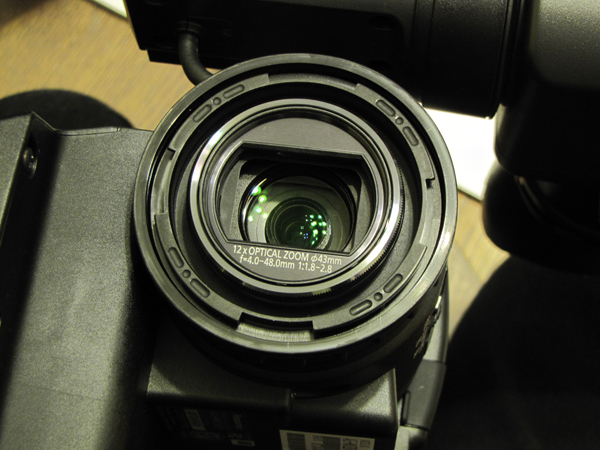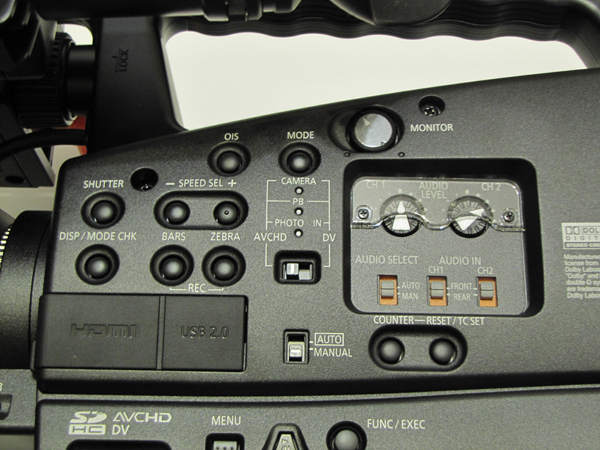Review: Panasonic AG-HMC80 Shouldermount Camcorder
In an era of ever-shrinking HD cameras, cell phone HD, and DSLRs, you might ask, why would anyone need an on-shoulder HD camcorder? Is it the copious amount of I/O jacks? The ergonomics? Or the easy access to numerous features in a big camera sort of way that enamor the Panasonic AG-HMC80 to its target end users? Let's find out.
GOTTA BE THE JACKS!
One of the primary features of the HMC80 is the preponderance of I/O jacks that do not require any special cabling or adapters. Composite video (downconverted with your choice of letterboxing or edge crop), component video, HDMI, and even FireWire for DV recorded in camera. There's RCA audio out, headphones out, XLR audio in (line/mic, with phantom power), 1/8" stereo audio out, and a USB jack for accessing the SD card on computers that lack a media reader slot. There are also several little cable holders mounted around the camcorder to manage the accessories that will inevitably find themselves velcro'd to the camcorder.
The only omission is S-video, but there's little advantage to S-video over composite. My only lament is that component out uses up the jack for composite, so you can't do both. In fact, the humble beginnings of this camcorder limit the HMC80 to only one live output at a time. Simultaneous output from HDMI out, component out, and composite out are not possible The order of priority is HDMI, component, composite.
Another wonderful feature is that there are two "remote" ports to control the camcorder's Zoom and Start/Stop of Recording on one jack, Focus and Iris on the other jack. You can extend control of these features to physical devices you place on the handles of a tripod and operate this camcorder much like a "studio" camera. Moreover, this electronic control of focus is easier and cheaper than the external, geared focus hardware you use on the big broadcast glass lenses.
However, the "studio configuration" is a key place where you need the multiple video outputs. If you are recording internally this is not as much an issue, but the "studio configuration" is where multiple cameras are used in a studio in a live situation. The camera operator is now standing several feet behind the camera and needs a display, like a 7" screen, to see what the camera sees. At the same time, the control room needs the HD feed from the camcorder, probably over component video cables. The HMC80's limit of one active output means you need to loop a feed back to the camera from the control room. That's an extra hassle that could be avoided if the HMC80 could do multiple video outputs simultaneously.
NOTES
The HMC80's big square lens hood comes off. It's quite impressive but really not needed. Someday a camcorder manufacturer is going to ship a camcorder with a hood that will hold filters and have adjustable flags. Then the big hood will become useful again. Till then, it's just an aesthetic issue.
Under the hood you find the same 12x optical lens as the HMC40 with a 43mm filter thread. You can wait for lens accessories to use the Panasonic bayonet mount, or go with threaded accessories right now. Interestingly, you can remove this lens cover too and work your way down to another 43mm thread if you need to get your wide-angle adaptoer even closer to the actual lens. If not, this is where you put your UV filter to protect the lens from dust and debris.

The HMC80's 12x optical lens
There is a way to jam sync the time code by putting the camcorders in DV mode and using a FireWire cable. When I asked Panasonic if the TC then carries over to HD mode, they said there's no way to do this. If it did, this would be an excellent way to jam multiple camcorders into free-run time code that matches. Maybe they could enable this in a firmware update.
The HMC80 actually features a Synchro Scan shutter. While this proved to be an invaluable feature when tube displays all featured some odd scanning rate that became painfully visible with any camera pan or tilt, the need for it has diminished greatly with the prevalent usage of flat-screen displays. However, there are still issues with the flicker of fluorescent lamps in LED screens, and with the RGB flickering of DLP displays. The manual also notes that panning quickly will distort the image-but this is a well-known native function of the rolling shutter of CMOS chips, and not a problem with this camcorder.
NITS TO PICK
On the HMC80's body the power switch surrounds the thumb switch and, unlike what you may be used to, you have to flick it down to turn the camera on, and up to turn the camera off. I'd prefer the reverse, but that's just me.
The battery release button is not as effective as it could be because there's no springloading of the battery that I could find. The button has a hard plastic shroud which makes it hard to press in, especially if you have gloves on (remember the cold and snows from right around Christmas?). It ends up being more difficult than it needs to be.
The printed documentation that ships with the camera is a "starter" manual and a most of the features I was looking for were listed on pages that were not in the starter manual. The rest of the manual is on CD. A camcorder with as many features as this ought to have the full printed manual included. There is plenty of room to pack the full manual with this big camcorder, so it's certainly not a size/space restriction.
The HMC80 has numerous audio input control switches. Selecting Left/Right/Both for audio monitoring through the speaker/headphone ought to be a physical switch, too. During a shoot, if I hear some noise, I need to isolate it quickly. Which channel has the noise I hear? Digging through the menus for this capability makes it far less useful.

Audio input control switches on the HMC80
The audio-level dials are tucked under a clear plastic shell, and all of this is in a recessed section of the operator's side of the camcorder. This made it hard to minutely tweak audio settings while shooting. Thankfully, two phillips screws takes the clear plastic cover off. I think the recessed location provides enough protection.
You can't play back HD clips when the camcorder is in DV mode. Really, it's just data, and you'd expect it to play anything back at any time. So you might be shocked that all your clips appear as unplayable blue squares. But rest assured they are still stored in the camera, even when you can't play them.
The waveform monitor takes up a small portion of the display, and it has no markers on it. So it takes time to figure out where zero IRE is, where 100 IRE is, every time you call it up. Making it larger, and giving it the appropriate labels would help immensely.
Multiple live outputs should be a requirement on a feature-filled camcorder such as this one-especially given that it seems designed to also work in a multicamera studio configuration.